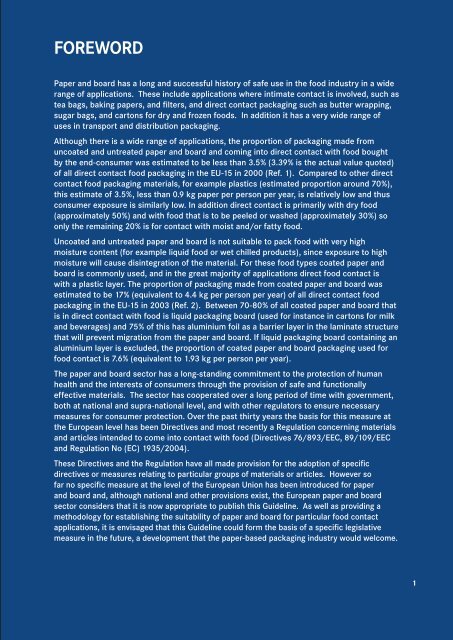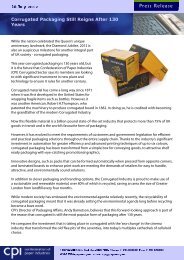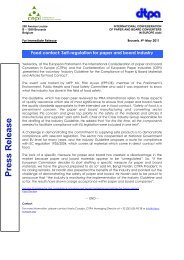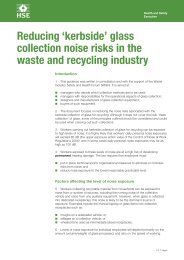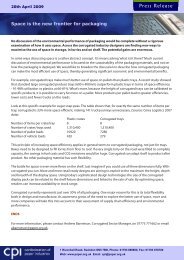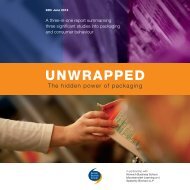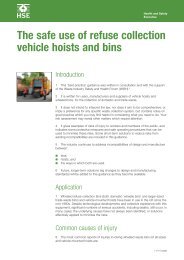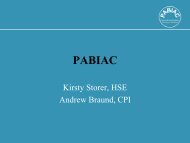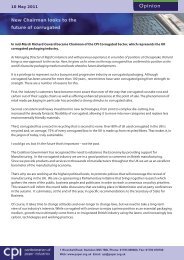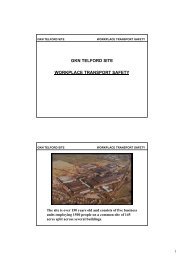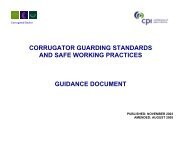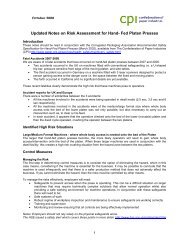Industry guideline for the Compliance of Paper & Board ... - cepi
Industry guideline for the Compliance of Paper & Board ... - cepi
Industry guideline for the Compliance of Paper & Board ... - cepi
You also want an ePaper? Increase the reach of your titles
YUMPU automatically turns print PDFs into web optimized ePapers that Google loves.
Foreword<br />
<strong>Paper</strong> and board has a long and successful history <strong>of</strong> safe use in <strong>the</strong> food industry in a wide<br />
range <strong>of</strong> applications. These include applications where intimate contact is involved, such as<br />
tea bags, baking papers, and filters, and direct contact packaging such as butter wrapping,<br />
sugar bags, and cartons <strong>for</strong> dry and frozen foods. In addition it has a very wide range <strong>of</strong><br />
uses in transport and distribution packaging.<br />
Although <strong>the</strong>re is a wide range <strong>of</strong> applications, <strong>the</strong> proportion <strong>of</strong> packaging made from<br />
uncoated and untreated paper and board and coming into direct contact with food bought<br />
by <strong>the</strong> end-consumer was estimated to be less than 3.5% (3.39% is <strong>the</strong> actual value quoted)<br />
<strong>of</strong> all direct contact food packaging in <strong>the</strong> EU-15 in 2000 (Ref. 1). Compared to o<strong>the</strong>r direct<br />
contact food packaging materials, <strong>for</strong> example plastics (estimated proportion around 70%),<br />
this estimate <strong>of</strong> 3.5%, less than 0.9 kg paper per person per year, is relatively low and thus<br />
consumer exposure is similarly low. In addition direct contact is primarily with dry food<br />
(approximately 50%) and with food that is to be peeled or washed (approximately 30%) so<br />
only <strong>the</strong> remaining 20% is <strong>for</strong> contact with moist and/or fatty food.<br />
Uncoated and untreated paper and board is not suitable to pack food with very high<br />
moisture content (<strong>for</strong> example liquid food or wet chilled products), since exposure to high<br />
moisture will cause disintegration <strong>of</strong> <strong>the</strong> material. For <strong>the</strong>se food types coated paper and<br />
board is commonly used, and in <strong>the</strong> great majority <strong>of</strong> applications direct food contact is<br />
with a plastic layer. The proportion <strong>of</strong> packaging made from coated paper and board was<br />
estimated to be 17% (equivalent to 4.4 kg per person per year) <strong>of</strong> all direct contact food<br />
packaging in <strong>the</strong> EU-15 in 2003 (Ref. 2). Between 70-80% <strong>of</strong> all coated paper and board that<br />
is in direct contact with food is liquid packaging board (used <strong>for</strong> instance in cartons <strong>for</strong> milk<br />
and beverages) and 75% <strong>of</strong> this has aluminium foil as a barrier layer in <strong>the</strong> laminate structure<br />
that will prevent migration from <strong>the</strong> paper and board. If liquid packaging board containing an<br />
aluminium layer is excluded, <strong>the</strong> proportion <strong>of</strong> coated paper and board packaging used <strong>for</strong><br />
food contact is 7.6% (equivalent to 1.93 kg per person per year).<br />
The paper and board sector has a long-standing commitment to <strong>the</strong> protection <strong>of</strong> human<br />
health and <strong>the</strong> interests <strong>of</strong> consumers through <strong>the</strong> provision <strong>of</strong> safe and functionally<br />
effective materials. The sector has cooperated over a long period <strong>of</strong> time with government,<br />
both at national and supra-national level, and with o<strong>the</strong>r regulators to ensure necessary<br />
measures <strong>for</strong> consumer protection. Over <strong>the</strong> past thirty years <strong>the</strong> basis <strong>for</strong> this measure at<br />
<strong>the</strong> European level has been Directives and most recently a Regulation concerning materials<br />
and articles intended to come into contact with food (Directives 76/893/EEC, 89/109/EEC<br />
and Regulation No (EC) 1935/2004).<br />
These Directives and <strong>the</strong> Regulation have all made provision <strong>for</strong> <strong>the</strong> adoption <strong>of</strong> specific<br />
directives or measures relating to particular groups <strong>of</strong> materials or articles. However so<br />
far no specific measure at <strong>the</strong> level <strong>of</strong> <strong>the</strong> European Union has been introduced <strong>for</strong> paper<br />
and board and, although national and o<strong>the</strong>r provisions exist, <strong>the</strong> European paper and board<br />
sector considers that it is now appropriate to publish this Guideline. As well as providing a<br />
methodology <strong>for</strong> establishing <strong>the</strong> suitability <strong>of</strong> paper and board <strong>for</strong> particular food contact<br />
applications, it is envisaged that this Guideline could <strong>for</strong>m <strong>the</strong> basis <strong>of</strong> a specific legislative<br />
measure in <strong>the</strong> future, a development that <strong>the</strong> paper-based packaging industry would welcome.<br />
1


